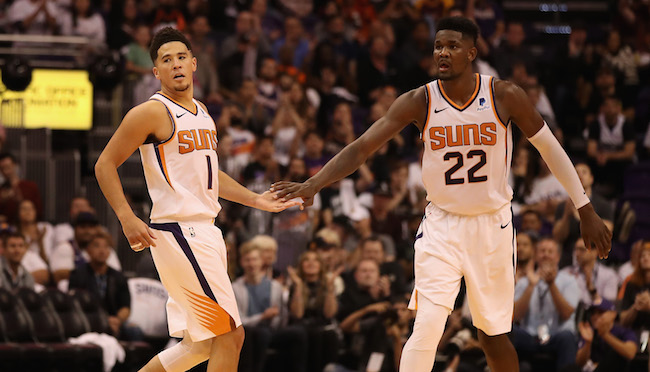
There is a lot of intrigue surrounding new Phoenix Suns head coach Igor Kokoskov, who moved from Utah to Phoenix to take over a club with a lengthy history of innovative and successful offensive coaches, from Paul Westphal in the early 1990s to Mike D’Antoni in the mid-2000s. Kokoskov brings European influence to the Suns, one built around teamwork and a philosophy of passing up a good shot for a great one that has held quite a few great coaches in good stead over the years.
The Suns’ offense has lacked a certain amount of creativity in recent seasons. Kokoskov has already changed that in a big way through the first few games of his tenure on the bench, as the new-look Phoenix attack has been far more democratically than the 2017-18 version.
It’s still early in the season, but the Suns are averaging the second-most passes per game (through October 23) after passing the ball better than just eight teams last year. It helps to have personnel on the perimeter who can hit shots to whom the Suns’ playmakers can pass the ball, but there’s no doubt that Kokoskov’s values offensively are permeating the team on the floor.
With that in mind, let’s take a look at a particular set play Phoenix ran against the Dallas Mavericks in each team’s opening game last week. It’s a set I’m calling “STS Hammer,” and it gives the Suns a few different options throughout.
The main objective is to get the ball to the corner for a three-pointer, but if that fails, there’s a release valve in the middle of the floor for a quick-hitting jumper for Deandre Ayton. A lot of Hammer sets flounder when guarded correctly, because the offensive player along the baseline often has nowhere to go with the ball if the pass to the shooter isn’t open, but Kokoskov has designed an extra action to both help that shooter get open and give Ayton a path to the paint if things don’t go as planned.
It’s not often you see this type of screen-the-screener action. Usually, it’s reserved for one player setting a cross or flex screen along the baseline before whirling around a screen himself toward the perimeter for a jumper or a curl back toward the basket. Instead, Phoenix has Isaiah Canaan set a back screen for Ayton to, perhaps, catch a lob at the rim before T.J. Warren sets a screen for Canaan to cut down toward the baseline. While there’s some chance that Ayton is open at the rim or Canaan is immediately unguarded for a layup, the primary purpose of all this screening action is to distract the defense from Devin Booker, who flares down to the corner behind an Ayton screen.
Canaan’s first option is to continue his cut toward the baseline, take one dribble, and fire the ball to an open Booker for a three-pointer. However, the Suns had run a few Hammer sets earlier in this particular game against Dallas and the Mavericks were ready for it. As Wesley Matthews got through Ayton’s screen, Dwight Powell sagged off Ayton as he set the screen, cutting off Canaan’s angle to the corner and seemingly blowing up the Hammer action.
However, this is where Phoenix’s extra attention to detail offensively comes into play. For most teams, Ayton’s final responsibility would be to set that screen for Booker, but there’s an extra move in Kokoskov’s Hammer sets that make them more effective than others. Ayton cuts toward the ball after setting the screen on Matthews, and because Powell is busy denying the pass to the corner, he’s wide open for a pass and short jumper.

In many ways, the action between Booker and Ayton is similar to a standard pick-and-roll, because Powell has to sink back while Matthews gets through the screen and Ayton was open on the “roll.” Given Ayton’s particular skill with the ball in these areas, what would normally be a relatively low-efficiency outcome is actually a very good result for the Suns, whether they get it to Booker in the corner or to Ayton in the paint. Plus don’t forget about the spacing provided by Warren and Trevor Ariza; they move up toward the top of the key to make sure their defenders can’t help down easily onto Ayton or take away that pass as well.
The Suns likely aren’t going anywhere special this year within the context of the Western Conference at large, but having a strong duo in Booker and Ayton and a creative coach like Kokoskov could just be the start of something special. They’re already immensely more fun to watch offensively as they learn how to play together and how screening and moving without the ball creates the best opportunities for them and their teammates.
They don’t have a ton of other pure creators on the roster, but with Kokoskov’s offensive philosophies and specific sets, they don’t necessarily need a bunch of guys who can break down a defense off the dribble, because the ball and man movement does the work for them.






